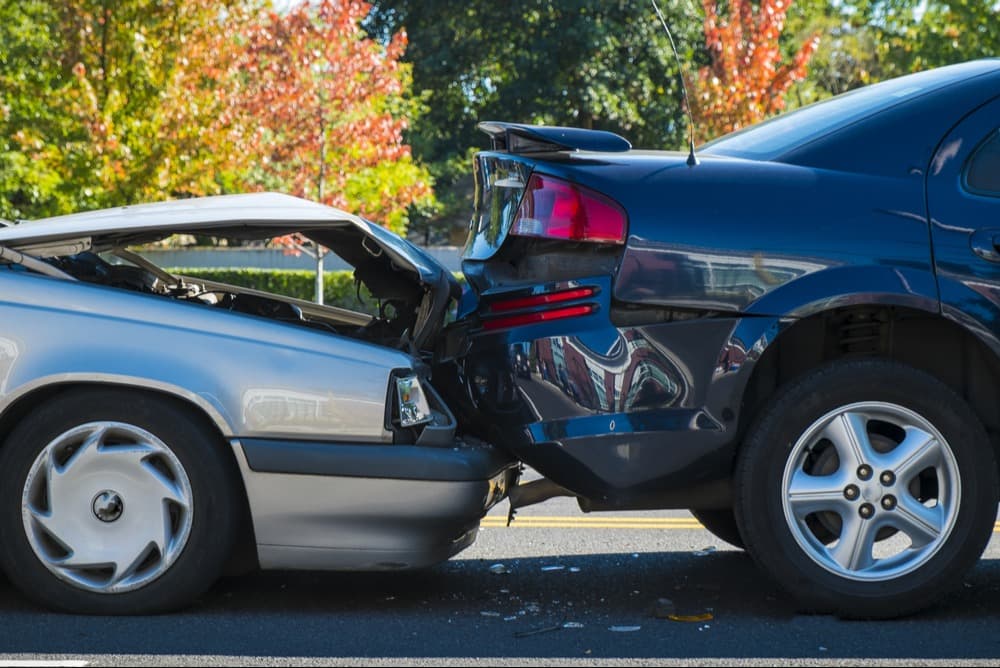A rear-end collision’s frequency doesn't diminish the potential for severe injuries and significant property damage. Whether at a stoplight, stuck in traffic, or moving along the road, having a vehicle hit yours from behind is usually unexpected, leaving you with little to no time to react. This abrupt impact can result in many injuries, some of which may not manifest immediately.
Ensuring you take the right steps after a rear-end collision is critical—from taking care of your health and gathering the necessary information to hiring a skilled personal injury lawyer who can navigate the complex intricacies of your claim.
Understanding Rear-End Collisions

According to the National Highway Traffic Safety Administration, rear-end collisions are the most common type of accident on U.S. roadways, accounting for nearly a third of all motor vehicle crashes. While these accidents are most likely to occur when the lead vehicle stops or slows down, such as at a red light or stop sign, they can happen anywhere and at any time.
Drive-Safety.net reports that a rear-end collision occurs somewhere in the United States every eight seconds, meaning there are roughly 2.5 million of these collisions a year. While rear-end accidents are commonly minor incidents or fender-benders, statistics show that these accidents—even at relatively low speeds—can lead to life-altering injuries or even death.
In a typical rear-end collision, one vehicle hits another from behind. This situation happens for various reasons, including distracted driving, speeding, tailgating, poor weather conditions, sudden stops, or even mechanical failures. Negligence plays a fundamental role in determining liability in rear-end collisions. The driver who strikes a vehicle from behind is generally negligent, as they failed to maintain a safe distance.
The following are some exceptions:
- The front vehicle's brake lights were not functioning, resulting in the driver of the following car not having ample warning that the driver had slowed or stopped.
- The front vehicle suddenly stopped in the roadway for no reason.
- In a chain-reaction crash at a stoplight, one vehicle rear-ended another, pushing the lead vehicle into the car in front of it. In many cases, the driver who caused the initial accident will be liable for the damages to both vehicles.
- Evidence shows that the lead vehicle was traveling in reverse when the accident occurred.
- There is evidence that the driver of the lead vehicle brake checked the following car. According to Jerry Insurance, brake checking refers to a driver deliberately slamming on their brakes to make the driver behind stop following so closely or even to cause a rear-end accident.
Given the sudden and unexpected nature of most rear-end accidents, they often result in injuries to the occupants of the front vehicle. Common injuries in rear-end collisions include whiplash and back, head, and spinal injuries. Any injury, no matter how minor it seems, can seriously influence your life and livelihood.
Seeking Compensation After You Suffer Injuries in a Rear-End Collision
Negotiating the legal aftermath of a rear-end collision while dealing with physical and emotional trauma can be overwhelmingly complicated. Having an experienced personal injury lawyer beside you can make a significant difference. A lawyer can understand the specific legal context of your situation, guide you through the process, and fight for your rights, ensuring that you can focus on what's most important: your recovery.
Steps to Take After a Rear-End Accident
Seeking medical attention immediately after any accident is crucial, even if you don't feel hurt at the scene. Doing so is vital for your health and plays a significant part in any future legal actions you may decide to take. Document and treat your injuries appropriately without delay.
At the scene, if possible, collect information. Include details from the other driver, witnesses, photos of the scene, and vehicle damage. Remember, it's about gathering facts; your lawyer can guide you on the most significant information. It's worth noting that you and your attorney should handle this information collection process so that it does not implicate you in any wrongdoing. As innocuous as some statements can seem in a stressful situation, people may use them negatively in a compensation claim.
The initial steps after a rear-end collision can set the tone for any legal actions that may follow. Having a lawyer throughout the process can provide clarity and direction, ensuring that you are taking all the proper steps.
Understanding Your Legal Rights
A rear-end collision usually creates an assumption of fault against the driver of the rear vehicle. This situation is still subject to evidence, witness testimony, and local traffic laws. The legal nuances in establishing fault in a car accident can be complex, and your lawyer's experience will be invaluable. They interpret and apply laws relevant to your situation, ensuring the upholding of your rights.
Dealing With Insurance Companies
The legal proceedings following a collision often involve multiple parties, including insurance companies. Insurance companies can be challenging to deal with directly, as they might try to minimize their payout or dismiss the claim altogether. Having an experienced lawyer representing you ensures these companies handle your claim fairly and justly.
The Deadline and Other State-Specific Legalities of Your Claim
Note that each state has its own laws about personal injury claims and traffic accidents. The timeframe within which you can file a lawsuit, known as the statute of limitations, varies by state, with most states requiring the parties of a legal dispute to initiate court proceedings within one to five years after the date of the accident.
Missing this deadline may result in losing your right to use the court process when seeking compensation for your injuries. Once the statute of limitations has expired, the insurance company no longer has the obligation to resolve the claim. An experienced personal injury lawyer can manage the timing of the claims process to ensure that all your windows to collect compensation remain open.
The claims process also varies by state. Some locations are tort states, meaning those who have suffered injuries due to a rear-end collision due to another driver's negligence can immediately file a claim against the other party's auto liability insurance. These are commonly called at-fault states.
Other states are no-fault states, where it is a requirement for all registered drivers to obtain a personal injury protection policy and—with the exception of serious injuries or death—to access compensation from their own provider after suffering injuries in an accident, regardless of who was at fault.
A lawyer can examine the insurance policies you and the at-fault driver hold to find the appropriate resources for compensation.
Handling the Legal Legwork
The insurance claim process can feel overwhelming after a rear-end collision. Dealing with the paperwork, figuring out how to substantiate your claim, and negotiating with the insurance adjusters require immense time, patience, and knowledge. A seasoned personal injury lawyer and their legal team can handle these stressful and time-consuming tasks.
One of the first steps in this process is collecting relevant evidence. This may include police reports, medical records, photos of the accident scene, witness testimonies, and even dashcam footage. Your lawyer will painstakingly compile this information, presenting a thorough case that leaves no stone unturned.
Beyond the tangible evidence, your lawyer will also calculate the actual cost of your pain and suffering. This typically includes current and future medical bills, lost income, property damage, and noneconomic damages, such as emotional distress and loss of enjoyment of life. Using their experience and understanding of similar cases, your lawyer can estimate these costs more accurately, ensuring adequate compensation for your ordeal.
Your lawyer will initiate the claim and oversee and manage the entire process on your behalf. Some steps include analyzing your medical records, estimating your vehicle's repair costs, documenting your pain and suffering, and gathering all necessary evidence to substantiate your claim. From submitting the initial claim to negotiating a fair settlement with the insurance company, your lawyer remains your advocate, ensuring that your best interests are always a priority.
The Settlement Negotiation Process
Insurance companies often employ aggressive negotiation strategies to minimize their financial obligation. They may try to downplay the severity of your injuries or even suggest that the accident was partially your fault to reduce their financial responsibility for your claim. In such situations, your lawyer can provide the necessary counterbalance, using their experience and legal know-how to fight for a fair settlement.
Remember that reaching a settlement isn't always the final step. Disagreements over the claim can sometimes lead to litigation. If your case does head to court, your lawyer will be ready to represent your interests, armed with the evidence and arguments to advocate for your rights.
The nature of your injuries may require an opinion or testimony from a professional who is not necessarily responsible for your treatment. A medical professional may, for example, analyze your medical documents and testify about the extent of your injuries and the prognosis for your recovery. Your lawyer can identify and coordinate with these witnesses, enhancing your claim.
Filing a Lawsuit
If the insurance company fails to make a settlement offer that fairly compensates your claim, you can file the claim as a lawsuit. Settlement negotiations may continue even after you file a lawsuit, and your lawyer plays a vital role here. They can use their negotiation skills and a deep understanding of your case to argue for a fair settlement.
If your case does reach trial, you can trust your lawyer to present your case compellingly, cross-examine witnesses, and counter the defense's arguments. This rigorous pursuit of your legal rights ensures you receive the compensation you deserve for the damages you've suffered.
Affording an Experienced Car Accident Attorney
Building a comprehensive compensation claim after a rear-end collision requires meticulous attention to detail and a profound understanding of personal injury law. You can rest assured that a dedicated personal injury lawyer will craft your claim with diligence, accuracy, and a clear focus on your best interests. Many people who suffer injuries in rear-end accidents, unfortunately, avoid seeking the legal help they need because they think they can't afford an attorney's services.

Most personal injury lawyers provide services through a contingency billing method. According to Cornell University's Legal Information Institute, a contingency fee arrangement allows personal injury claimants to hire an attorney without paying upfront or for services by the hour. You pay your legal team for their services only when you receive compensation for your claim. You then pay them a percentage of the overall total of your award.
Remember, each rear-end collision case is unique, and with their guidance and experience, your car accident lawyer can understand your situation's specifics. They can light the way, transforming a daunting journey into a navigable pathway toward justice and recovery.